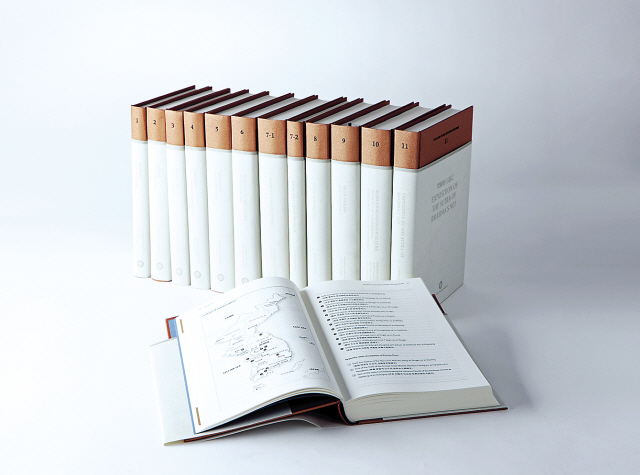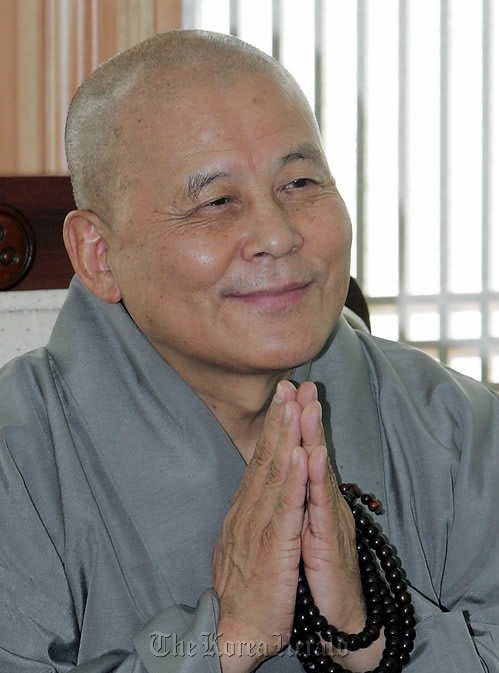Jogye Order publishes bilingual series on Korean Buddhism
By Korea HeraldPublished : Aug. 23, 2012 - 20:28

Late Ven. Jigwan’s ambitious project comes together seven months after his death
Jogye Order, the nation’s largest Buddhist sect, has published an English and ancient Chinese bilingual book series on the teachings of Korean Buddhism, it announced this week.
The 13-volume series, titled “Collected Works of Korean Buddhism,” contains teachings of celebrated monks throughout Korean history, including Wonhyo (617-686), Jinul (1158-1210) and Hyujeong (1520-1604). The series’ Korean edition, translated from the ancient Chinese texts, was published last year.
The series, also translated from the original Chinese texts, is the result of an ambitious project initiated by the late Ven. Jigwan, who served as the executive chief of the Jogye Order from 2005 to 2009. The project began in 2006 with the support of the Culture Ministry.
“This series is mainly for scholars and those who are interested in learning Korean Buddhism,” said Kwon Ki-chan, researcher of The Jogye Order Institute for the Study of Buddhism and Society.
Jogye Order, the nation’s largest Buddhist sect, has published an English and ancient Chinese bilingual book series on the teachings of Korean Buddhism, it announced this week.
The 13-volume series, titled “Collected Works of Korean Buddhism,” contains teachings of celebrated monks throughout Korean history, including Wonhyo (617-686), Jinul (1158-1210) and Hyujeong (1520-1604). The series’ Korean edition, translated from the ancient Chinese texts, was published last year.
The series, also translated from the original Chinese texts, is the result of an ambitious project initiated by the late Ven. Jigwan, who served as the executive chief of the Jogye Order from 2005 to 2009. The project began in 2006 with the support of the Culture Ministry.
“This series is mainly for scholars and those who are interested in learning Korean Buddhism,” said Kwon Ki-chan, researcher of The Jogye Order Institute for the Study of Buddhism and Society.

“We felt that there really aren’t many English-language resources on Korean Buddhism overseas. Many cannot differentiate Korean Buddhism from Chinese Buddhism. This series is to serve as a basic guide for those who would like to research Korean Buddhism.”
Kwon said the late Ven. Jigwan was particularly keen on the quality of the translation of the series. A total of 46 local and foreign scholars participated as editors and translators for the series, including UCLA’s Buddhist scholar Robert Buswell, University of Tokyo’s A. Charles Muller and Dongguk University’s Ven. Haeju.
“Many scholars hold different views on the featured monks’ teachings and texts,” Kwon told The Korea Herald. “Late Ven. Jigwan stressed the importance of providing an impartial translation of the texts, in spite of the translators’ varied opinions on them.”
The collective translation process was in fact inspired by the way ancient Buddhist translators worked in China’s Sui (589-618) and Tang (618-907) Dynasties, said Kwon.
In Sui and Tang, there were a total of nine different roles in a group of Buddhist translators. Among the nine, one would make the initial translation of the Sanskrit texts ― the Indo-Aryan and literary language of Buddhism. The other eight translators were each responsible for different tasks, including grammar, scholarly interpretations, diction and sentence structures.
“Most translators today either work alone or with one or two partners,” said Kwon.
“But because these Buddhists texts are complex and can be interpreted in many different ways, one or two translators may unconsciously end up adding their subjective views into their works. That’s why we got many scholars and translators to work on this project together, just like the way it was done in the old times ― to make it fair and academically neutral.”
The newly published series will be distributed to foreign universities and academic institutions, the order said.
By Claire Lee (dyc@heraldcorp.com)
-
Articles by Korea Herald







![[KH Explains] Hyundai's full hybrid edge to pay off amid slow transition to pure EVs](http://res.heraldm.com/phpwas/restmb_idxmake.php?idx=644&simg=/content/image/2024/04/18/20240418050645_0.jpg&u=20240419100350)







![[From the Scene] Monks, Buddhists hail return of remains of Buddhas](http://res.heraldm.com/phpwas/restmb_idxmake.php?idx=652&simg=/content/image/2024/04/19/20240419050617_0.jpg&u=20240419175937)

![[KH Explains] Hyundai's full hybrid edge to pay off amid slow transition to pure EVs](http://res.heraldm.com/phpwas/restmb_idxmake.php?idx=652&simg=/content/image/2024/04/18/20240418050645_0.jpg&u=20240419100350)

![[Today’s K-pop] Illit drops debut single remix](http://res.heraldm.com/phpwas/restmb_idxmake.php?idx=642&simg=/content/image/2024/04/19/20240419050612_0.jpg&u=)